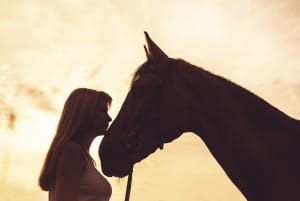A new study on the facial expressions of horses may bring us closer to understanding the unique way that humans and horses communicate, and perhaps explain why horses can be powerful allies in the treatment of addiction, anxiety, depression, PTSD and more. Humans and horses have a storied history. Together, we’ve tilled the land, fought wars, traveled the world and built entire civilizations. So closely are we joined that horses seem to be able to communicate with us — to read us, and to sooth us in a visceral way. In the last few decades, growing numbers of psychotherapists have attempted to tap into this relationship by incorporating horses into mental health treatment, in what is known as equine-assisted psychotherapy (EAP). Although there’s scant published scientific research on the effectiveness of equine-assisted therapy, most people who’ve seen the results are believers. “When I do equine work, I feel like I’m witnessing grace,” said Dede Beasley, M.Ed, LPC, an equine-assisted therapist for The Ranch in Nunnelly, Tennessee. “These precious animals allow people to bring all kinds of issues into the horse’s world, and the horse will accept them as they are — imperfections and all.” Now, researchers have discovered an important piece of information that could explain at least part of the connection. Investigators at the University of Sussex, in the United Kingdom, carefully studied facial movements in horses, and based on that information, created a directory of facial expressions. This directory, or “Facial Action Coding System,” can be used in future studies aimed at better understanding how horses think and feel. The study also found that horses use facial muscles in much the same way humans do, which could help to explain the two-way communication that humans and horses seem to share. “What surprised us was the rich repertoire of complex facial movements in horses, and how many of them are similar to humans,” said co-lead author, doctoral researcher Jennifer Wathan in a news release. “What we’ll now be looking at is how these expressions relate to emotional states,” she said. The researchers were able to identify 17 individual facial movements in horses — which compares with 27 in humans — and is more than has been tallied for chimps or dogs. The finding didn’t surprise Beasley. “I observe the horses very carefully and listen to them intently, and I know they do that with me,” said Beasley, who has more than three decades of experience working with horses. “There is an ongoing conversation between us.” Beasley uses her body motions to communicate, and the horse does the same. “The ears, head, carriage, eyes, nostrils and mouth all hold truths about a horse’s experience every moment,” she said. “My eyes constantly scan what the horse has going on, and the face is an essential part of him as a communicator; it’s not always a brief conversation either.” Beasley was one of the first practitioners to be certified by the North American Handicapped Riders Association as an equine-assisted psychotherapist.
What Is Equine-Assisted Psychotherapy?
EAP involves pairing a human with a four-footed therapist in a corral under the guidance of a mental health professional who, in some cases, is accompanied by an equine specialist. The treatment team leads the client through a series of activities with the horse that are designed to address issues the client is working through. For example, when a client who is struggling with anxiety and trust issues witnesses the horse overcoming its own fear in order to perform a task with the client, the interaction helps the client put his own fear into perspective. “Sometimes people are unaware of their behavior and how it affects others until the horse reacts to them,” said Beasley. “The horse has no hidden agenda, and it’s hard to argue with a horse’s perception.” There are a few different EAP models in the U.S. The leading international nonprofit organization for EAP professionals is the Equine Assisted Growth and Learning Association (EAGALA). The group provides certification, education and support for EAP professionals and is growing worldwide. Since its launch in 1999, EAGALA has grown to more than 4,500 members in 50 countries. The Professional Association of Therapeutic Horsemanship International also offers an equine-facilitated mental health program that is available in about 150 locations worldwide, nearly double what it was offering in 2007.
Equine-Assisted Psychotherapy Works In Mysterious Ways
Still, no one is entirely sure how EAP works. “It may be that one type works better for some people and another type is better for others, however we need to understand more about the underlying processes before we will know this,” Wathan wrote in an email. “I would be very interested to know whether facial expressions, and particularly those that we share with horses, help the communication process.” Because EAP is essentially experiential, therapists believe that in some cases it can tap into deeply rooted emotions and painful experiences in ways that are highly impactful. Horses speak a universal language of sorts, and they are able to mirror what the client is feeling, and to react to the client, which provides information for the therapist. Working with a horse can quickly expose a person’s maladaptive thought and behavior patterns. In an equine therapy session, Beasley sometimes draws metaphors between the client’s interaction with the horse and the patterns in their own lives, addressing such issues as boundaries and communication. And sometimes the simplest lessons are the most powerful. Beasley recalled one client who had suffered atrocious early childhood trauma. Rather than designing a structured equine therapy session for the young woman, Beasley encouraged her to simply sit in the pasture with the horse. At the end of the session, the client said quietly, “I’ve never had anybody so big be nice to me before.” (Sources: Equine Assisted Growth and Learning Assn. [www.eagala.org], Equine Therapy Group [www.equinetherapygroup.com], horsecollaborative.com, PBS.org, Public Library of Science (PLOS/ONE), sciencedaily.com, University of Sussex)

